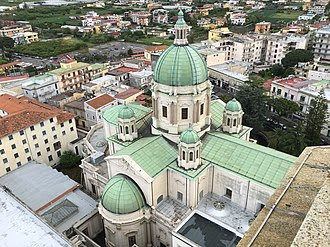Basilicas in Italy—Campania 1
I blogged about the following basilica on November 13, 2019.
- Primatial Cathedral Basilica of St. Mary of the Angels, St. Matthew, and St. Gregory VII in Salerno.
Basilica of St. Michael the Archangel, Sant’Angelo in Formis, Caserta
Considered a minor basilica for centuries.
The church was originally built in the 6th Century by the Lombards on the site of a Roman temple and was rebuilt in the 11th Century in a Romanesque style. Many of the church’s frescoes date to the 11th Century. The portico and bell tower date to the 12th Century.
All pictures are from Wikipedia.
Cathedral Basilica of the Assumption of Mary, Capua, Caserta
Declared a minor basilica by Pope Leo XII in 1827.
The Basilica is the cathedral for the Archdiocese of Capua. Originally built in 856, it has been rebuilt and renovated several times including the 1950s. The church therefore has elements of three styles—Romanesque, Baroque, and Modern.
All pictures are from Wikipedia.
Royal Basilica of St. Francis of Paola, Naples, Naples
Declared a minor basilica by Pope Gregory XVI in 1836.
The Neoclassical Basilica was built between 1816 and 1846.
All pictures are from Wikipedia.
Pontifical Basilica of Our Lady of the Rosary of Pompeii, Pompeii, Naples
Declared a minor basilica by Pope Leo XIII in 1901.
The Basilica was built at the instigation of Blessed Bartolo Longo and was constructed in a Neo-classical style between 1876 and 1901. It is the cathedral for the Territorial Prelature of Pompeii and it was enlarged between 1934 and 1938 to cover 54,000 square feet. Four million pilgrims visit each year to venerate Mary as the Madonna of Pompeii.
All pictures are from Wikipedia.
Basilica of St. Januarius, Naples, Naples
Declared a minor basilica by Pope Pius X in 1905.
Januarius was an early 4th Century bishop who was martyred by beheading. Someone collected a portion of his blood in vials. With only a few exceptions, the coagulated blood liquefies on three specific days each year. For centuries, the vials were kept in chapels until the current eclectic church was built between 1904 and 1968.
Pictures are from Wikipedia.
Basilica of St. Alphonsus Liguori, Pagani, Salerno
Declared a minor basilica by Pope Pius X in 1908.
This church was designed by St. Alphonsus and built between 1756 and 1803 under the direction of an architect. The church is the burial place of St. Alphonsus.
The first three pictures are from Wikipedia and the last is from Flickr.
Basilica of St. Trofimena, Minori, Salerno
Declared a minor basilica by Pope Pius X in 1910.
Construction of the neoclassical church began in 1747 and was completed in the early 1800s. St. Trofimena, a 7th Century Christian martyr, is buried in the church. The church once served as the cathedral for a now-suppressed diocese.
Pictures are from Flickr and a local source.
Royal Basilica of St. James (the Greater), Naples, Naples
Declared a minor basilica by Pope Pius X in 1911.
The Baroque church was built between 1540 and 1741. It was commissioned by the Spanish Viceroy. The church has a number of paintings from the 16th, 17th and 18th Centuries.
Pictures are from Expedia, Flickr, and TripAdvisor.
Basilica of St. Mary, Meta di Sorrento, Naples
Declared a minor basilica by Pope Pius X in 1914.
In the 8th Century, a deaf and mute woman found a statue of the Madonna under a laurel shrub and was immediately cured. Chapels were built but were never large enough to accommodate the number of pilgrims. Work on the current Baroque church began in 1569 and continued until the 1700s.
The first three pictures are from TripAdvisor and the last is from Wikipedia.
Basilica of St. Michael the Archangel, Piano di Sorrento, Naples
Declared a minor basilica by Pope Benedict XV in 1914.
The church dates to the 9th Century and is located on the site of a Roman temple. It was rebuilt in 1405, badly damaged by an earthquake in 1688, and again rebuilt in a Baroque style. The church has several works of art.
The first two pictures are from local sources and the last two are from Wikipedia.
Basilica of St. Mary, Largo Pozzano, Naples
Declared a minor basilica by Pope Benedict XV in 1916.
In the early 15th Century, a man found a painting of the Madonna in a well. A church was built in the early 16th Century, but before long, the number of pilgrims dropped off and the Franciscans who administered the church were expelled by local authorities. But then, St. Francis himself visited the church and prayed there for three days and three nights. Soon thereafter, Pope Julius II sent the Franciscans back to the church. The church was renovated and enlarged in the 18th Century. Two world wars and an earthquake damaged the church in the 20th Century, but it has been restored.
All pictures are from Wikipedia.
Basilica of Our Lady of Mount Carmel, Naples, Naples
Declared a minor basilica by Pope Benedict XV in 1917.
The church dates to the 13th Century but was renovated in a Neapolitan Baroque style in the 18th Century. The basilica is associated with several events in the history of Naples which are beyond the scope of this blog. The church has a brown Madonna that has conflicting origin stories, but likely was made in Tuscany in the 13th Century. There is also a “miraculous” crucifix from the 15th Century.
All pictures are from Wikipedia.















































































